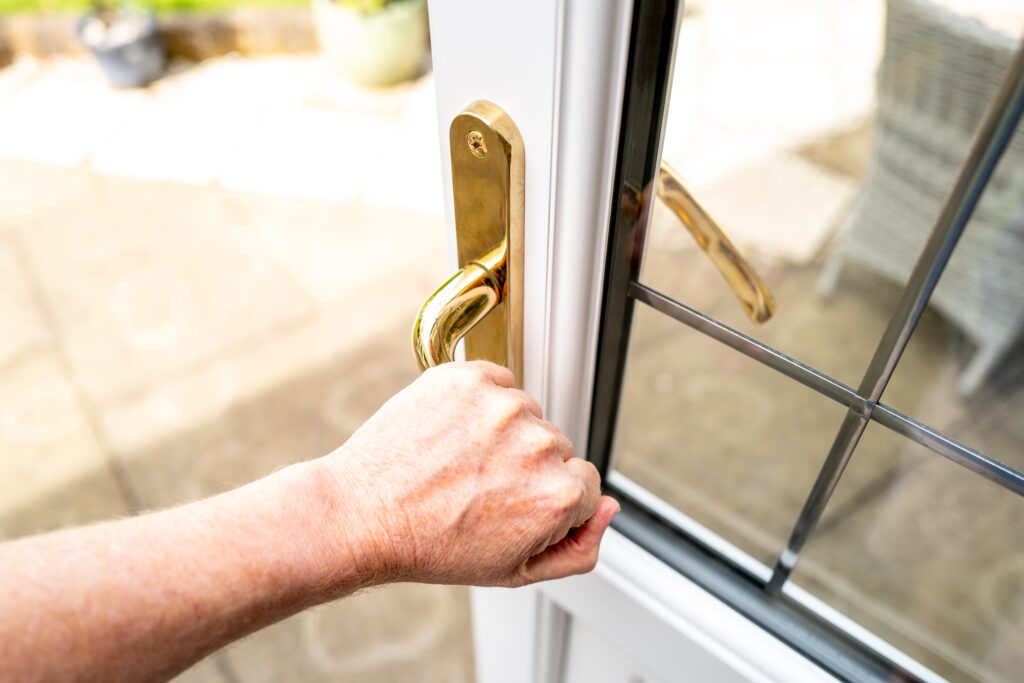How Much Does Patio Door Replacement Cost?

When your patio door starts sticking, letting in drafts, or simply looks outdated, it might be time for a replacement. Patio doors aren’t just functional entryways to your outdoor spaces, they’re also major contributors to your home’s energy efficiency, security, and overall aesthetic appeal. Whether you’re upgrading for style, addressing damage, or improving insulation, understanding the costs involved helps you plan your patio door replacement budget effectively.
Table of Contents
Average Cost of Patio Door Replacement
The national average cost to replace a patio door ranges between $1,550 and $6,250, with most homeowners spending around $2,500. This price variance reflects the wide range of door types, materials, and installation requirements available.
Typical Costs:
- Materials: $1,000–$4,850 (door unit, hardware, weatherstripping)
- Labor: $400–$1,400 (typically $65–$120 per hour for 3–7 hours of work)
Your final cost will depend on the door type you select, its size, materials, glass options, and whether any structural modifications are needed.
Cost by Patio Door Type
Patio doors come in several distinct styles, each with its own price range, benefits, and ideal applications. Your choice of door type not only affects your budget but also impacts your home’s appearance, functionality, and energy efficiency. From space-saving sliding doors to dramatic bifold systems, understanding the options helps you select the perfect balance of performance and value for your specific needs.
Sliding Glass Doors
Cost range: $1,000–$3,000
Sliding glass doors feature at least one stationary panel and one that glides horizontally along tracks. They’re ideal for spaces where swing-out doors would be impractical.
Pros:
- Space-efficient—no clearance needed for door swing
- Excellent for unobstructed views
- Generally more affordable than other options
Cons:
- Limited opening width (typically half the door width)
- Tracks require regular cleaning for smooth operation
Best for: Areas with limited space or where maximizing views is a priority.
French Doors
Cost range: $900–$5,900
These hinged doors typically come in pairs and swing outward or inward. They’re distinguished by their multiple glass panels and traditional aesthetic.
Pros:
- Elegant, classic appearance
- Can open fully for maximum passage width
- Good ventilation options
Cons:
- Require swing clearance space
- Generally less energy-efficient than sliding doors
Best for: Traditional homes or spaces where a grand entrance to the outdoors is desired.
Bifold Doors
Cost range: $3,000–$10,000
Bifold doors consist of multiple panels that fold against each other like an accordion when opened. They can span large openings and create a seamless transition between indoor and outdoor spaces.
Pros:
- Can open almost the entire doorway
- Create a dramatic indoor-outdoor connection
- Impressive for entertaining spaces
Cons:
- Among the most expensive options
- Complex installation and operation
Best for: Large openings and homeowners looking to make a statement with their indoor-outdoor transition.
Multi-Slide or Telescoping Doors
Cost range: $1,500–$5,000
These doors feature three or more panels that slide and stack behind one another when opened, providing a wide, unobstructed opening.
Pros:
- Provide larger openings than standard sliding doors
- Modern, sleek appearance
- Great for indoor-outdoor living
Cons:
- Require sufficient wall space for stacked panels
- More complex installation than standard sliders
Best for: Contemporary homes with sufficient wall space adjacent to the opening.
Pocket Sliding Doors
Cost range: $1,200–$3,500+
These doors slide completely into a wall cavity when opened, disappearing from view entirely.
Pros:
- Complete unobstructed opening
- Clean, minimalist aesthetic
- No visible stacked panels
Cons:
- Require substantial wall modifications
- More expensive installation
- Limited accessibility for repairs
Best for: Modern, minimalist designs where clean lines are a priority and wall space allows.
Key Factors That Influence Patio Door Replacement Cost
The final price of your patio door replacement depends on several critical variables beyond just the basic door unit. Understanding these factors helps you budget accurately and make informed decisions about where to invest for the best value. From materials and glass options to size considerations and installation requirements, each element contributes significantly to your total project cost. Here’s what impacts your bottom line most dramatically.
Door Material
The material of your patio door affects everything from its appearance and durability to its maintenance requirements and energy efficiency. Here’s what you need to know about each option before making your decision.
Vinyl (uPVC): Budget-Friendly Performance
Cost range: $300–$1,200
Vinyl doors offer remarkable value with their combination of affordability and low maintenance. These doors won’t rot, corrode, or require painting, making them perfect for busy homeowners seeking hassle-free solutions.
Aluminum: Sleek Modern Style
Cost range: $600–$2,500
For contemporary homes, aluminum provides clean lines and maximum glass area due to its strength-to-weight ratio. These doors excel in moderate climates but require thermal breaks in extreme temperatures.
Wood: Timeless Natural Beauty
Cost range: $500–$3,000
Nothing matches the warmth and character of wood patio doors. Available in various species from pine to mahogany, wood doors can be stained or painted to complement any architectural style, though they require regular maintenance.
Fiberglass: Premium Durability
Cost range: $800–$3,500
When performance matters most, fiberglass delivers with superior resistance to warping, rotting, and extreme weather. These doors can convincingly mimic wood grain while offering the stability modern homeowners demand.
Steel: Ultimate Security
Cost range: $2,000–$4,000
For maximum protection, steel doors provide unmatched strength and security. Though more expensive than other options, they offer peace of mind in high-traffic or security-conscious settings.
Composite: Balanced Performance
Cost range: $600–$1,300
Combining wood fibers with polymer resins, composite doors offer the look of wood with enhanced durability and reduced maintenance requirements—an excellent middle-ground solution.
Glass Options
The glass in your patio door significantly affects both price and performance:
Insulating Glass Options
Standard double-pane glass has become the baseline for modern patio doors, offering reasonable energy performance at an accessible price point. For premium climate control, triple-pane glass (adding $300–$500) provides superior thermal performance and noise reduction—ideal for homes in extreme climates or noisy environments.
Performance Enhancements
Low-E coatings (adding $100–$500) are microscopic metallic layers that selectively filter sunlight, blocking heat and damaging UV rays while allowing visible light through. Gas fills like argon or krypton (adding $300–$550) between panes significantly improve insulation performance compared to regular air, reducing heat transfer and improving overall energy efficiency.
Specialty Glass Options
Impact-resistant glass (adding $300–$500 for standard, $1,000–$3,000 for hurricane-rated) stays intact when broken, protecting against storms and intruders—essential for coastal areas. Tempered safety glass (adding $700–$1,000) breaks into small, dull pieces rather than dangerous shards, enhancing family safety and meeting building codes. Decorative and privacy glass options (adding $500–$1,000) allow light transmission while maintaining privacy through textures or patterns.
Size and Customization
Standard patio doors typically range from 60 to 144 inches wide and 80 to 96 inches tall. Each square foot of door adds approximately $10–$50 to the total cost. Custom sizes outside these ranges will significantly increase your price, often by 25–50%.
Energy Efficiency Ratings
Doors with higher energy efficiency ratings (like ENERGY STAR certified products) typically cost 10–15% more but can reduce energy bills by an average of 12%. Look for:
- U-factor (lower is better)
- Solar Heat Gain Coefficient (SHGC)
- Air leakage ratings
Labor and Installation Costs
Professional installation typically runs $400–$1,400, varying by:
- Regional labor rates
- Installation complexity
- Contractor experience
- Season (peak seasons often command premium rates)
Structural Modifications
Creating a new opening or modifying an existing one adds considerable expense:
- Widening an existing opening: $1,000–$2,500
- Creating a new wall opening: $2,000–$8,000+
- Adding supporting headers: $500–$1,500
Additional Costs to Consider
Removal and Disposal of Old Door
Removing and properly disposing of your existing patio door typically costs between $100 and $400. Most professional installers include this service in their quotes, but it’s worth confirming before signing a contract.
Permits
Depending on your location, permits for patio door replacement can cost anywhere from $50 to $300. Requirements vary significantly by municipality—some areas require permits only for structural modifications, while others mandate them for any exterior door replacement.
Hardware Upgrades
Quality hardware not only enhances the appearance of your patio door but also improves security and functionality. Door handles and locks range from $40 for basic models to $250 for premium designs with enhanced security features.
Weatherproofing and Insulation
Proper weatherproofing and insulation, costing between $300 and $600, are critical for energy efficiency and preventing water damage. This includes weatherstripping to seal gaps, caulking around the door frame, and foam insulation to prevent drafts. Professional installers typically include basic weatherproofing in their installation price, but premium weather-resistance packages may cost extra.
Painting or Finishing
Budget $200-$500 for painting or finishing work associated with your new patio door. Wood doors require staining or painting to protect against moisture and UV damage. Even with pre-finished doors, you might need to repair, prime, and paint the surrounding trim to match your new installation.
Patio Door Replacement Cost by Region
Labor rates vary significantly by region, affecting your total project cost:
Higher Cost Regions:
- Northeast (particularly Boston, New York City)
- West Coast (especially California)
- Major metropolitan areas
Lower Cost Regions:
- South
- Midwest
- Rural areas
The difference can be substantial—up to 20–30% variance in total project cost between high and low-cost regions. Always get local quotes to understand pricing in your specific area.
DIY vs. Hiring a Professional
Deciding whether to install your patio door yourself or hire a pro involves weighing potential savings against skill requirements and risks. Here’s what to consider before making your choice.
DIY Installation
Installing a patio door yourself can save $400-$1,400 in labor costs. This route requires intermediate carpentry skills, specialized tools, and at least one helper to manage the door’s weight. Most DIYers need 1-3 days to complete what professionals finish in hours.
The biggest risks with DIY include improper sealing leading to water damage, alignment issues affecting operation, and potentially voided manufacturer warranties. DIY works best for simple replacements using the exact same door type and size.
Professional Installation
Professional installers bring expertise in precise leveling, weatherproofing, and structural assessment. They typically complete installations in under a day, guarantee their work, and maintain your manufacturer’s warranty coverage.
Quality contractors provide detailed written estimates, proof of insurance, and references from similar projects—investments that often prevent costly problems down the road.
For complex doors like bifolds, telescoping systems, or situations requiring structural changes, professional installation is essential for both safety and performance.
Finding Qualified Patio Door Installers
Look for contractors with specific patio door experience, proper licensing, and insurance. Request references from similar projects and check online reviews. The best installers will offer detailed written estimates and clear project timelines.
How to Save on Patio Door Replacement
Replacing your patio door doesn’t have to break the bank. These practical strategies can help you reduce costs while still getting a quality installation.
Compare Multiple Quotes
Get at least three estimates from different contractors. Compare not just price but also materials, labor details, and warranty coverage. Watch for quotes significantly below average—these often indicate corners being cut.
Schedule Off-Season Installation
Plan your replacement for fall or winter when demand is lower. Many contractors offer 10-15% discounts during slower months, and manufacturers frequently run promotions during these periods.
Look for Energy Incentives
Check for ENERGY STAR tax credits, utility company rebates, and manufacturer promotions for energy-efficient doors. These incentives can offset higher upfront costs for better-performing doors.
Stick to Standard Sizes
Custom door dimensions can increase your costs by 25-50%. When possible, choose standard sliding door widths (5′, 6′, 8′, 9′, or 12′) and heights (6’8″ or 8’0″) to keep expenses down.
Consider Partial Updates
Instead of replacing the entire door unit, explore replacing just the door panels or damaged hardware. New rollers, tracks, or weatherstripping can dramatically improve performance at a fraction of full replacement cost.
Maintain or Upgrade Existing Frames
If your door frame remains in good condition, replacing just the glass panels can save hundreds. Most manufacturers offer replacement panels that work with existing frames.
FAQs
How long does it take to replace a patio door?
Professional installation typically takes 3–7 hours for a standard replacement. If structural modifications are needed, the project may extend to 1–3 days.
Will replacing my patio door improve energy efficiency?
Yes, modern patio doors with double or triple-pane glass, low-E coatings, and proper weatherstripping can significantly reduce energy costs—potentially saving 10–15% on heating and cooling expenses in the area served by the door.
Do I need a permit for patio door replacement?
For straightforward replacements that don’t alter the structure, permits are usually not required. However, if you’re changing the size of the opening or making structural modifications, most jurisdictions will require a permit. Always check with your local building department.
Can I install a new door in an existing wall?
Yes, but this is a major project requiring structural knowledge to properly support the weight above the opening. Costs typically range from $2,000–$8,000 and almost always require permits and professional installation.
Are sliding patio doors cheaper than French doors?
Generally, sliding doors and French doors have comparable cost ranges, but basic sliding doors tend to be less expensive than basic French doors. The final cost depends more on materials, size, and features than door type.
How long do patio doors last?
With proper maintenance, quality patio doors typically last 20–30 years. Vinyl and fiberglass doors generally require less maintenance than wood or aluminum to achieve their full lifespan.
Conclusion
Replacing a patio door represents a significant investment in your home, with costs typically ranging from $1,550 to $6,250. While the expense may seem substantial, a quality patio door offers returns through improved energy efficiency, enhanced home security, and increased property value.
The wide price range reflects the numerous options available—from economical vinyl sliding doors to premium multi-panel systems. By understanding the factors that influence cost, you can make informed decisions that balance your budget with your performance and aesthetic requirements.
For the best results, take time to research your options, get multiple quotes from reputable installers, and consider long-term value rather than focusing solely on initial cost. A well-chosen patio door can enhance your home’s beauty and functionality for decades to come.
Ready to start your patio door replacement project? Contact trusted local installers today to receive personalized quotes based on your specific needs and home configuration.
Additional Home Improvement Resources

Anna has over six years of experience in the home services and journalism industries and serves as the Content Manager at MyHomePros.com, specializing in making complex home improvement topics like HVAC, roofing, and plumbing accessible to all. With a bachelor’s degree in journalism from Auburn University, she excels in crafting localized, comprehensive guides that cater to homeowners’ unique needs. Living on both coasts of the United States has equipped her with a distinctive perspective, fueling her passion for turning any house into a cherished home through informed, personalized decision-making.








